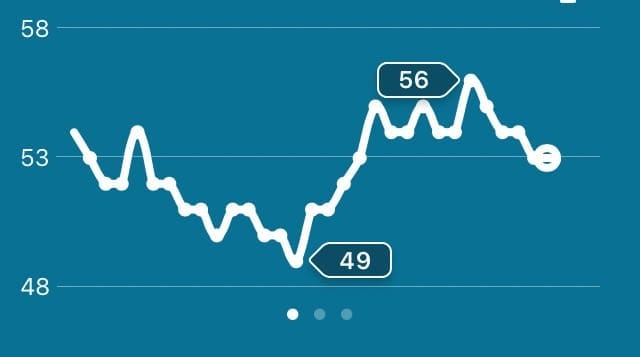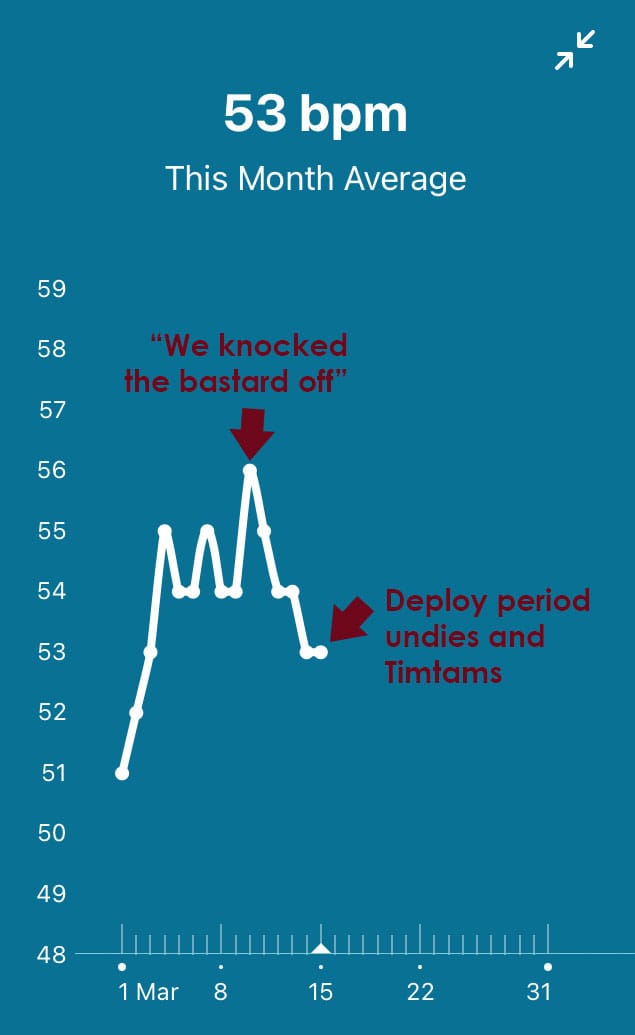I hacked my Fitbit and now I know the exact day my period's arriving
Fitbit records a number of health metrics but doesn't seem to use them to make its menstrual tracking more accurate. Moata explains how you can more accurately predict your period using resting heart rate.

Firstly, I want to preface this post by pointing out that yes, this is the fifth anniversary of the Mosque attacks that cut a horrifying scar through an already quite scarred city. I do have thoughts on that, and what I felt that day and how it affected me, but I generally feel that this day isn't about me - I am not the voice that needs to be heard on that topic on this day. I encourage you to read Guled Mire instead. That said, I am trying get back into a writing habit and I started this newsletter a week ago so below is something I'd been thinking about writing about for a little while.
A hearty "sorry-not-sorry" to those of the twelve of you who have signed up to this here newsletter who are not uterine owner-operators like myself. This isn't really for you, but you might learn something so hang around if you feel like it, I guess?
Me and my Fitbit strolling down the avenue (to make my prescribed number of steps per hour)
I have had a Fitbit for several years now, and I really appreciate the way it lets me monitor things like patterns in my sleeping, and it's helped me bit a bit less sedentary, even if its reminder at 10 minutes to the top of the hour that it would be a good time to get some steps in is bordering on the passive aggressive. I'm at that phase in life when it's a good idea to pay attention to stuff your body is doing. And although I'm not a major data nerd (I'm not exporting .CSV files and making them into charts like some kind of maniac) I do like me some data points.
Among the features of the Fitbit is a menstrual tracker, which is of course useful to us uterus-havers. But it's a bit of a basic set-up. You're encouraged to log when your period starts so it can then "predict" when you're likely to be ovulating and menstruating. It also gives you options to log "symptoms" like bad skin, bloating and "clamped a co-worker's mouth shut with a bulldog clip", I mean "moods". But it doesn't really do anything useful with that information except log it. It's not like your work wife who you can lean across a desk to complaining, "oh gawd, my boobs", who'll then say, "well, either you're pregnant or the painters will be in shortly". Nah, Fitbit is quite the basic bitch when it comes to guessing when your period is coming. It is operating entirely on numbers, working on probability like a card counter at a Black Jack table.
When will I, will I be menstruating? (I can answer, I can answer that)
Which is all fine and good. That will work reasonably well if you are someone whose period is always very prompt. But what if, and stay with me here, you are peri-menopausal? Or just a bit irregular? Or stressed? What if you've only got 5 pairs of period undies and you want to maximise your wearage. Those suckers take ages to dry. What if I wear them "just in case" two days in a row without Aunt Flo turning up? Now I've got to get them washed and dried in time for when they'll actually be of use.
So knowing exactly when your period will turn up is useful intel, and for reasons other than laundry. Which is where the data comes in.
Last year I noticed an interesting pattern in one of the health metrics my Fitbit gathers. My resting heart rate would hit a peak and then drop off again, and those peaks were roughly a month apart. Could they possibly correspond to my cycle? I did some searching and it turns out, yes they do. A paper published in 2015 found there was statistically significant variation in resting heart rate that corresponded to different menstrual phases.
So for the last few months I have been monitoring my menstrual cycle while keeping an eye on my resting heart rate, and comparing how well it predicts when my period will start compared to when my Fitbit thinks it will. Resting heart rate, I can now tell you, has been nailing it. The Fitbit is usually out by a day or two, occasionally more than that. My resting heart rate has accurately predicted the exact day I would get my period every time for 5 months.

Alright, clever clogs, hurry up and tell us how your witchcraft works.
If you have a Fitbit what you need to do is check in on the graph that shows your resting heart rate. You can have a look at multiple times across the month (or however long your cycle is) but the time you want to focus on is a week or so out from when your Fitbit thinks your next period will start. What you're looking for is a peak in your resting heart rate. If you check it and you're on an upward trend you might want to check every day until you see it start to come down. Once it's started its downward trajectory you'll want to count out from the peak. For me, my period is consistently turning up on day 5 post-peak. I'm not sure if 5 days is typical so you might want to make a mental note of how many days it is for you.

Then next month check again, count days out from the heart rate peak and see if it's accurate. As I said above, mine has been very on the money, even with a reasonable amount of variability in cycle length (between 26 and 30 days across 5 months).
In answer to your question, no I have no idea why Fitbit is not harnessing the data that it is already collecting in the interests of providing a better user experience for its uterus-having customers. But at least you now know how to work around it! I don't have any experience with other health trackers so don't know if any of them are doing a better job in this regard. Feel free to give me a shoutout on socials if they are.




